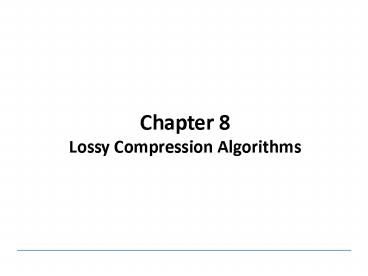Chapter 8 Lossy Compression Algorithms - PowerPoint PPT Presentation
1 / 19
Title:
Chapter 8 Lossy Compression Algorithms
Description:
Chapter 8 Lossy Compression Algorithms 8.1 Introduction Lossless compression algorithms do not deliver compression ratios that are high enough. – PowerPoint PPT presentation
Number of Views:267
Avg rating:3.0/5.0
Title: Chapter 8 Lossy Compression Algorithms
1
Chapter 8Lossy Compression Algorithms
2
8.1 Introduction
- Lossless compression algorithms do not deliver
compression ratios that are high enough. Hence,
most multimedia compression algorithms are lossy. - What is lossy compression?
- The compressed data is not the same as the
original data, but a close approximation of it. - Yields a much higher compression ratio than
that of lossless compression.
3
8.2 Distortion Measures
- The three most commonly used distortion
measures in image compression are - mean square error (MSE) s2,
- (8.1)
- where xn, yn, and N are the input data sequence,
reconstructed data sequence, and length of the
data sequence respectively. - signal to noise ratio (SNR), in decibel units
(dB), - (8.2)
- where is the average square value of the
original data sequence and is the MSE. - peak signal to noise ratio (PSNR),
- (8.3)
4
(No Transcript)
5
8.3 The Rate-Distortion Theory
- Provides a framework for
- the study of tradeoffs between
- Rate and Distortion.
- Rate Average number of bits
- required to represent each symbol.
- Fig. 8.1 Typical Rate
- Distortion Function.
6
8.4 Quantization
- Reduce the number of distinct output values to
a much smaller set. It is the main source of the
loss in lossy compression. - Three different forms of quantization
- Uniform Quantization.
- Nonuniform Quantization.
- Vector Quantization.
7
8.5 Transform Coding DCT
- The rationale behind transform coding
- If Y is the result of a linear transform T of
the input vector X in such a way that the
components of Y are much less correlated, then Y
can be coded more efficiently than X. - If most information is accurately described by
the first few components of a transformed vector,
then the remaining components can be coarsely
quantized, or even set to zero, with little
signal distortion. - Discrete Cosine Transform (DCT) will be studied
first.
8
Spatial Frequency and DCT
- Spatial frequency indicates how many times
pixel values change across an image block. - The DCT formalizes this notion with a measure
of how much the image contents change in
correspondence to the number of cycles of a
cosine wave per block. - The role of the DCT is to decompose the
original signal into its DC and AC components
the role of the IDCT is to reconstruct
(re-compose) the signal.
9
Definition of DCT
- Given an input function f(i, j) over two integer
variables i and j (a piece of an image), the 2D
DCT transforms it into a new function F(u, v),
with integer u and v running over the same range
as i and j. The general definition of the
transform is - (8.15)
- where i, u 0, 1, . . . ,M - 1 j, v 0, 1, .
. . ,N - 1 and the constants C(u) and C(v) are
determined by - (8.16)
10
2D Discrete Cosine Transform (2D DCT)
- (8.17)
- where i, j, u, v 0, 1, . . . , 7, and the
constants C(u) and C(v) are determined by Eq.
(8.5.16). - 2D Inverse Discrete Cosine Transform (2D IDCT)
- The inverse function is almost the same, with the
roles of f(i, j) and F(u, v) reversed, except
that now C(u)C(v) must stand inside the sums - (8.18)
- where i, j, u, v 0, 1, . . . , 7.
11
1D Discrete Cosine Transform (1D DCT)
- (8.19)
- where i 0, 1, . . . , 7, u 0, 1, . . . , 7.
- 1D Inverse Discrete Cosine Transform (1D IDCT)
- (8.20)
- where i 0, 1, . . . , 7, u 0, 1, . . . , 7.
12
- Fig. 8.6 The 1D DCT basis functions.
13
- Fig. 8.6 (contd) The 1D DCT basis functions.
14
(a)
(b)
- Fig. 8.7 Examples of 1D Discrete Cosine
Transform (a) A DC signal f1(i), (b) An AC
signal f2(i).
15
(c)
(d)
- Fig. 8.7 (contd) Examples of 1D Discrete Cosine
Transform (c) f3(i) f1(i)f2(i), and (d) an
arbitrary signal f(i).
16
- Fig. 8.8 An example of 1D IDCT.
17
- Fig. 8.8 (contd) An example of 1D IDCT.
18
The DCT is a linear transform
- In general, a transform T (or function) is
linear, iff - (8.21)
- where a and ß are constants, p and q are any
functions, variables or constants. - From the definition in Eq. 8.17 or 8.19, this
property can readily be proven for the DCT
because it uses only simple arithmetic operations.
19
2D Separable Basis
- The 2D DCT can be separated into a sequence of
two, 1D DCT steps - (8.24)
- (8.25)
- It is straightforward to see that this simple
change saves - many arithmetic steps. The number of iterations
required is reduced from 8 8 to 88.






























